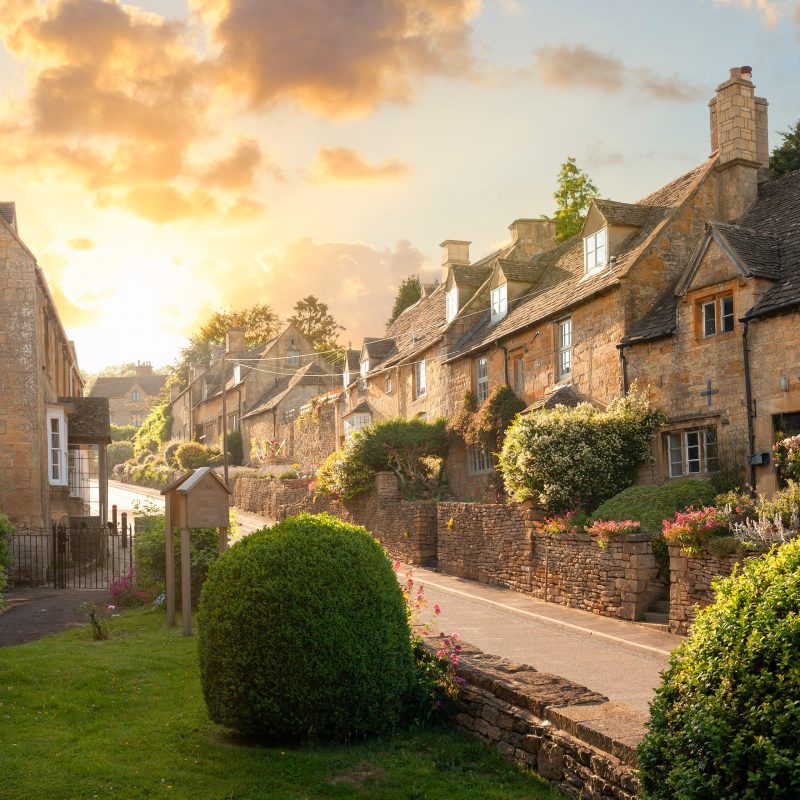
Note: The Travel Awaits team regularly updates content to provide the latest, and most accurate information to our readers. The updated content in this article may not reflect the views or opinions of the original author.
The Cotswolds, located just 2 hours west of London, may just be one of the most scenic parts of England. This collection of 113 towns and villages surrounded by rolling green pastures is an ideal choice for those looking for a slower-paced vacation in an idyllic setting.
Here are the reasons to consider the Cotswolds for your next getaway.
9 Reasons To Visit The Cotswolds, England
1. Cozy Bed And Breakfasts
While England’s big cities offer modern and high-tech hotels, the Cotswolds offers small, cozy bed-and-breakfast inns. Many of these got their start as coach houses hundreds of years ago. Often the inns are locally owned and operated. The internet speeds may be slow, but the hospitality is excellent. The included breakfasts are large and filling, leaving visitors well-fueled for a day of exploring the region.
The Porch House
The Porch House in Stow-on-the-Wold is England’s oldest pub. One of the beams inside the pub has been carbon-dated to prove that the establishment was founded in 947. Like most of the bed and breakfast inns in the area, The Porch House has been renovated to offer ensuite bathrooms and other modern amenities.
The Highway Inn
In Burford, The Highway Inn has been welcoming guests for 500 years. All the fireplaces are original and are still lit for guests every day. Some of the floors creak and others are sloped, but that just adds to the charm.
The Shaven Crown
For something even more unusual, try staying in a 700-year-old monastery. Originally founded by the monks of Bruern Abbey as a hospice, The Shaven Crown in Shipton-under-Wychwood offers comfortable rooms and a central location for exploring the Cotswolds.

2. Beautiful And Walkable
Dozens of trails wind through this friendliest town in England. Each of them offers walkers the opportunity to see both village and farm life. Typically, trails begin in one of the Cotswold villages and then head through miles of fields. Along the way, you’ll see plenty of cows, sheep, and horses, and some trails also include historic sites like Sudeley Castle or Hailes Abbey.
Companies like Macs Adventure and Hillwalk Tours can help you plan your walking vacation, including accommodations, route maps, and luggage service.
Cotswold Way
The longest and best-known trail is the Cotswold Way. This 100-mile path starts in the north at Chipping Campden and ends in the south at Bath Abbey. You can join the trail at any point along the way; just select the distance most comfortable for you.
Windrush Way
For something much shorter, consider the 14-mile Windrush Way. This path starts in Winchcombe and ends in Bourton-on-the-Water. Along the way, you’ll see the remains of medieval villages. This trail does not intersect with any villages, so be sure to pack plenty of food and water.

3. Biking The Region
Mountain biking has become increasingly popular in the Cotswolds. Like walking, this is an excellent way to see the countryside.
The dozens of popular cycling routes include the Infant Thames, the Burford Circular Ride, and the Winchcombe Circular Route. A list of most routes in the Cotswolds can be found here, including detailed maps and directions. Please note that while cyclists are not able to ride on pathways, they are allowed on byways and bridleways.
Bikes can be rented from several area companies, including Bainton Bikes and Hartwells Cotswold Cycle Hire. For assistance organizing a cycling vacation, check out Cotswolds Adventures or Windrush Cycle Tours.

4. Dozens Of Charming Villages
From the cottages made of yellow limestone to the colorful flower boxes hanging from the windows to the pubs with funny names dotting every corner, the Cotswolds could easily be a movie set for the BBC. Amidst the outstanding natural beauty of the Cotswolds, this collection of towns and villages offers visitors endless opportunities for shopping, dining, and simply relaxing.
It’s hard to know where to begin in the Cotswolds. Here are just a few villages to consider visiting in this glorious region.
Stow-On-The-Wold
Stow-on-the-Wold was founded in 1107 as a market town. At one time this was the epicenter of the wool industry in England. In the center of town is a 14th-century cross and the original stocks where criminals were punished.
Today the town is full of boutique shops, tea houses, and pubs. Before leaving, don’t miss Saint Edward’s Church and its rear door, supposedly the inspiration for the Doors of Durin from The Lord of the Rings.
Bourton-On-The-Water
Bourton-on-the-Water is often referred to as the Venice of the Cotswolds because of the River Windrush that runs through it and the five low-lying bridges that cross the water. This town is often voted the prettiest Cotswold village. While the general area is full of ruins dating to the Neolithic Period, the town was founded with the building of a church in the 11th century.
Today, visitors can enjoy relaxing in the open green spaces as well as exploring the surrounding shops.

Broadway
Broadway, one of the larger villages in the area, offers a particularly nice selection of shops and restaurants along its gently curving High Street. It’s believed that Broadway was founded when the nearby abbey was chartered by King Edgar in 972. For much of its history, this Cotswold village was a popular stop for coaches and then trains. It has since become a popular weekend getaway for Londoners.
After exploring the village, check out the Broadway Museum and Art Gallery or the nearby Broadway Tower.

5. Gorgeous Gardens
Visitors to this romantic small town in the UK frequently comment on how green everything is in the countryside. But plenty of other colors can be found in the dozens of gardens available to visitors. Some are quite formal, while others are more rustic. And no matter which part of the Cotswolds you’re in, there’s bound to be a garden nearby.
The best-known garden in the Cotswolds is Hidcote Manor Garden in Chipping Campden. Named one of the 10 Great British Gardens, Hidcote features a wide range of flowers, shrubs, and trees, many of them rare varieties. Bring a picnic to enjoy in this lovely setting.
Other popular gardens to visit include the Bourton House Garden in Bourton-on-the-Hill and the Westonbirt Arboretum in Westonbirt.

6. Rich History
History buffs will not be disappointed in the Cotswolds. The region offers opportunities to explore history dating as far back as 5,000 years.
Avebury Ring
For a glimpse of Neolithic history, head to the Avebury Ring. Located in the medieval town of Avebury, this stone circle was probably constructed between 2850 and 2200 B.C. Originally the site was made of 100 stones. After Christianity came to England, stone circles were considered remnants of paganism and were often destroyed. Today, some of the original stones remain, while smaller pillars are used as placeholders for the ones that no longer exist.
Sudeley Castle
Near Winchcombe is the 15th-century Sudeley Castle. This was once the home of Catherine Parr, one of the wives of King Henry VIII. Visitors can explore the ruins of a previous castle, tour the current castle, and appreciate the award-winning gardens.
Hailes Abbey Ruins
Also located near Winchcombe are the Hailes Abbey ruins. Founded in 1246 by the Earl of Cornwall, the abbey became an important Catholic pilgrimage site; however, it was destroyed in 1539 at the direction of King Henry VIII.
Blenheim Palace and Estate
Designed by Nicholas Hawksmoor and Sir John Vanbrugh, Blenheim Palace is most famous for being the birthplace of Winston Churchill, Britain’s World War II leader, whose grave you can see in the nearby Bladon village. Set over 2000 acres of parkland and gardens, Blenheim Palace is now home to the Duke of Marlborough. It offers tons of fun and a very busy events program all year round.
7. Local Pubs
No visit to the Cotswolds would be complete without a stop at a local pub. Fortunately, pubs aren’t hard to find. Most villages offer at least one pub, while the larger towns have dozens of choices. And within the region are many pubs that offer a bit of history along with a pint.
The Fountain Inn in Gloucester has a history dating back to 1216. Eight Bells Inn in Chipping Campden originally housed the stonemasons building the nearby Saint James’s Church in the 14th century. The Salutation Inn near Castle Combe was once the toll gate for travelers crossing the Roman Fosse Way.
Be sure to try the local draft beer while visiting these pubs. Unlike beers on tap, draft beers typically have less carbonation and may be served at room temperature.

8. Local Food
Since the Cotswolds are surrounded by farms and pastures, it’s easy for the area’s restaurants to provide fresh and local food — farm-to-table is the norm here. Many chefs take it one step further and have their own gardens on-site!
A visit should start with traditional English food like bangers and mash, shepherd’s pie, and fish and chips. These favorites can be found in nearly every pub throughout the region. But you should also be sure to explore some of the more creative dishes on offer.
At The Kingham Plough in Kingham, Chef Johnny Pons serves up modern versions of British classics. For French food, head to the Michelin-starred Le Champignon Sauvage in Cheltenham. If you’re looking for something more casual, try The Coconut Tree in Cheltenham, where Southeast Asian food is done very well.
9. Wildlife Attractions
The Cotswold forests showcase outstanding natural beauty. They are a stronghold for water voles, otters, brown hares, and an elusive hedgehog. But the woodlands aren’t the only place for wildlife spotting. Cotswold Wildlife Park and Cotswold Farm Park offer plenty of opportunities to get up close and personal with all manner of creatures.
Cotswold Wildlife Park
Set in 160 acres of landscaped parkland, the Cotswold Wildlife Park exhibits over 260 different species of animals. See lemurs in the Madagascar enclosure, watch rhinos graze on the lawns in front of the Gothic Manor House, or get eye-to-eye with the world’s tallest mammal on the new Cotswold Wildlife Park Giraffe Walkway.
Cotswold Farm Park
Unlike Cotswold Wildlife Park, this park is the home to domestic rare breeds of farm animals including Gloucestershire Old Spot Pigs and Highland cattle. It is the perfect place to learn all about farming past and present, and there’s plenty of entertainment for children of all ages as well.
FAQs
What Is Special About the Cotswolds?
The Cotswolds region is famous for stunning English landscapes filled with outstanding natural beauty of lovely green Cotswold hills, stone bridges, woodland, and charming country houses. Many cottages and manor houses are made from sandy yellow Cotswold Stone.
How Old is the Cotswolds?
The Cotswolds’ history dates back over 6000 years. The most likely origin of the name is that ‘cot’ refers to the sheep enclosures, which are an all too common sight in the area. ‘Wolds’ in the Cotswolds means rolling hills.
How Many Days Do You Need in the Cotswolds?
To explore the Cotswolds region properly, you’ll need between three and five days. Longer stays will allow you to visit fine-dining restaurants, and explore picturesque villages, ancient woodlands, and wildflower meadows.
What Are the Most Popular Villages in the Cotswolds?
The Cotswolds is dotted with postcard-perfect villages and market towns like Broadway, Bourton-on-the-Water, Moreton-in-Marsh, and many more. Because the Cotswolds covers such a large area of the country, deciding which Cotswold town to visit can seem like an impossible task.
What Is the Main Part of the Cotswolds?
The Cotswold area lies within five English counties and covers 800 square miles in south-central and southwest England. In recognition of its rich, diverse landscape it was designated an Area of Outstanding Natural Beauty in 1966.
